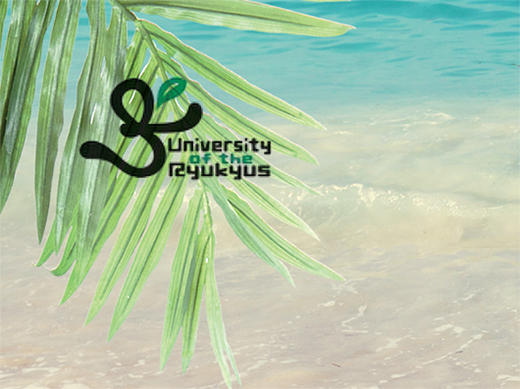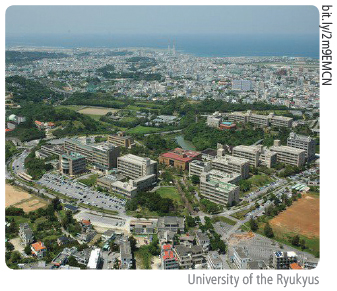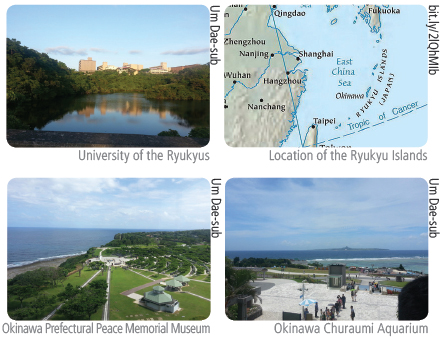

The University of the Ryukyus (琉球大学; UOR) is the westernmost national university in Japan. It is located in the town of Nishihara, Okinawa Prefecture, which is about 30~40 minutes away, by bus, from Naha, the capital city of the Okinawa Prefecture.
The University was established in 1950 on the ruins of the Shuri Castle (located in present day Naha) under the support of the United States Civil Administration of the Ryukyu Islands. The administration of the University was transferred to the Ryukyu Government in 1966, and in 1972 the University became a national university with the reversion of Okinawa to Japan. The University moved to its location today in 1977 while the Shuri Castle was being restored.
Today, the University is attended by about 8,000 students and employs a staff of about 1,700.

The Okinawa Prefecture comprises the Ryukyu Islands along with some of the islands of the Kagoshima Prefecture. The biggest island in the Prefecture is the island of Okinawa, where the capital of the prefecture, Naha, is located. The total population is about 1,400,000, of which about 300,000 live in Naha.
The climate ranges from humid subtropical to tropical rainforest, which means that the area is usually warmer than many other regions, especially during the winter.
The Ryukyu Kingdom was founded in the 15th century by Sho Hashi, who had united the three kingdoms of the island of Okinawa. The kingdom paid tribute to China while prospering through maritime trade. In 1609, the Ryukyu Kingdom was invaded by the Shimazu clan of the Satsuma domain in Japan and ultimately became its vassal state. In 1879, the Ryukyu kingdom was annexed by Japan and was renamed the Okinawa Prefecture. During the Second World War, Okinawa became a battlefield, inflicting heavy loss on the local society. After the war, Okinawa was under American control until 1972 when Okinawa was handed over to Japan by the United States.

Going to another university as an exchange student is having a long trip to a foreign country. For students planning to participate in the exchange program, some information and advice will help them prepare.
Um Dae-sub (Dept. of Business Administration, ’11) is a student of UOS who spent six months, from March until August, at UOR in 2016. Um has some stories to share from this experience.
Housing
“The dormitory you get to use matters a lot. The lifestyle differs depending on which dormitory you live in,” Um said. According to Um, some dormitories have better air conditioning and refrigerators than others. “This is important because the climate is rather hot and humid,” he recalled.
Food
“Since there are not many restaurants around the university, you have to buy a snack, use the school cafeteria, or make your own food. If the local food does not suit you, you have to make your own food,” Um said. He also mentioned that the local food was a bit salty in general in his opinion.

Activities
“If you have a hobby, try to find a club related to it,” Um said. “I personally recommend the diving club. It allows you to experience maritime sports in Okinawa for a comparatively cheap cost,” he added.
Beside joining clubs, Um also recommended attending exchange meetings. “When you go to UOR as an exchange student, you will often have classes with other exchange students who are learning Japanese with you. Usually, you do not have many chances to make local friends. Joining activities such as exchange meetings will help you make local friends and learn Japanese,” Um explained.
In addition to in-school activities, there are several places you can visit outside the school. Okinawa has various tourist attractions. For example, the Shuri Castle, mentioned above, was the palace of the Ryukyu kingdom and was designated a UNESCO World Heritage Site in 2000. For people interested in modern history, the Okinawa Prefectural Peace Memorial Museum, a place to commemorate the battle of Okinawa in 1945, might be a good destination.
For people interested in ocean ecology or related fields, the Okinawa Churaumi Aquarium, where you can meet a vast range of rare marine creatures such as whale sharks and manta rays in large fish tanks where the ocean environment is recreated. “The true value of the aquarium is not the aquarium itself but its surroundings. There are dolphin shows every thirty minutes and a beach where you can swim,” Um recalled.
Things to Prepare
“If you have a driver’s license, change it into an international one. The local traffic is quite inconvenient, so it is better to rent a car instead,” Um said, “Most of the other things depend on what kind of dormitory you get to use. Probably a dehumidifier might help if you can get one.”
“To know about the university well, asking students who have returned from the university is the best way,” Um added. “And if you are finally decided as the exchange student, try to obtain information when contacting with the foreign university’s person in charge.”
“Although I was already a senior and did not know much Japanese when I left as an exchange student, I think that meeting other exchange students from other countries was a pleasant experience. By the virtue of it, I now have a positive mind and a wider perspective,” Um said, “For students preparing to be an exchange student, since it is only a semester or two that is given to you, be brave and active. That way, you will learn something.”
Shin Gi-sung
sgsparthia97@uos.ac.kr

